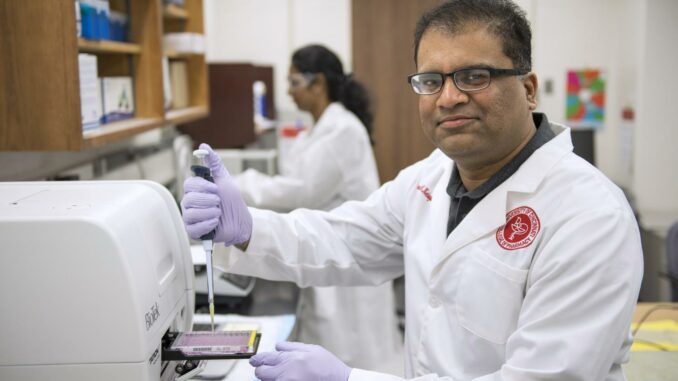
CINCINNATI (TIP): A federally funded study, led by an Indian American researcher Nalinikanth Kotagiri, looks to develop a new imaging method that can identify certain types of lung infections — in real-time — in order to speed up treatment for critically ill patients.
Kotagiri, an associate professor of pharmaceutical sciences at the UC James L. Winkle College of Pharmacy, has been awarded a five-year $3 million, R01 grant from the National Heart, Lung, and Blood Institute (NHLBI) to develop and study the effectiveness of different kinds of injectable probes (metallic contrast agents) that would collect at the site of the infection and immediately light up under a nuclear imaging machine, known as a PET scan, according to a University of Cincinnati press release. Currently, radiologists use chest X-rays to confirm the diagnosis of pneumonia and other infections in the lungs. An X-ray, however, cannot determine the specifics of the infection or whether the infection is bacterial, viral or fungal.
A specific diagnosis can only be determined by a pathologist, after culturing a sample of lung tissue which is collected from an invasive procedure (called a bronchoscopy) and takes time, typically two to three days.
Critically ill patients, however, such as those with infectious pneumonia and underlying conditions such as chronic obstructive pulmonary disease (COPD), might not have time to spare, says Kotagiri.
“Our solution is to use imaging to identify what is causing the pneumatic episode,” within hours, to hasten a treatment plan, he says. An added benefit, he says, is that the contrast agent development process “doesn’t require elaborate processing or preparation time.”
This is critical as the development of contrast agents can be time-consuming and complicated. A simple and fast process is expected to reduce preparation time in a clinical laboratory and potentially enable the adoption of the technology in a clinical setting.
With this study, in animal models, Kotagiri and colleagues will only be looking at bacterial and viral pneumonias in conjunction with COPD, but the imaging approach has the potential to apply to other types of infections such as fungal infections or conditions such as cystic fibrosis.
Imaging the patient after treatment, Kotagiri says, could also identify whether the patient is responding to medications such as antibiotics. Imaging could also potentially aid in determining the right antibiotics to use, targeting the pathogens that were identified.
The collaborators on this project include experts in COPD and lung diseases: Francis McCormack, MD, a pulmonologist, and Michael Borchers, Ph.D., at the University of Cincinnati. Changchun Xie, Ph.D., at the University of Cincinnati, is the team’s biostatistician, and Suzanne Lapi, Ph.D., at the University of Alabama-Birmingham, will provide the radiochemistry expertise to optimize contrast agent development.




Be the first to comment